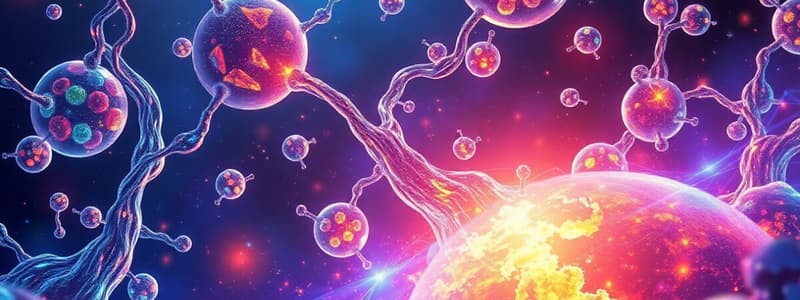Podcast
Questions and Answers
What occurs during a chemical reaction?
What occurs during a chemical reaction?
- Products remain unchanged.
- Energy is neither absorbed nor released.
- Reactants are combined without breaking any bonds.
- Bonds in reactants are broken and new bonds are formed in products. (correct)
Which type of reaction absorbs energy?
Which type of reaction absorbs energy?
- Exothermic reaction
- Endothermic reaction (correct)
- Catalytic reaction
- Activation reaction
What is the role of an enzyme in a chemical reaction?
What is the role of an enzyme in a chemical reaction?
- To speed up the reaction by lowering activation energy (correct)
- To change the nature of the products formed
- To store chemical energy
- To eliminate reactants
What term describes the reactants involved in an enzyme-catalyzed reaction?
What term describes the reactants involved in an enzyme-catalyzed reaction?
What can happen to an enzyme when it loses its shape?
What can happen to an enzyme when it loses its shape?
Which of the following describes the active site of an enzyme?
Which of the following describes the active site of an enzyme?
How can inhibitors affect an enzyme's activity?
How can inhibitors affect an enzyme's activity?
What determines the specificity of an enzyme?
What determines the specificity of an enzyme?
What is the main difference between reactants and products in a chemical reaction?
What is the main difference between reactants and products in a chemical reaction?
What characteristic of enzymes allows them to increase the likelihood of a chemical reaction occurring?
What characteristic of enzymes allows them to increase the likelihood of a chemical reaction occurring?
What happens when an enzyme becomes denatured?
What happens when an enzyme becomes denatured?
Which statement accurately describes the role of a catalyst in a chemical reaction?
Which statement accurately describes the role of a catalyst in a chemical reaction?
How do substrates interact with an enzyme's active site?
How do substrates interact with an enzyme's active site?
In what way can pH levels specifically affect enzyme activity?
In what way can pH levels specifically affect enzyme activity?
Which of the following describes the relationship between an enzyme and its substrate?
Which of the following describes the relationship between an enzyme and its substrate?
What is the effect of inhibitors on enzyme-catalyzed reactions?
What is the effect of inhibitors on enzyme-catalyzed reactions?
Which best describes an exothermic reaction?
Which best describes an exothermic reaction?
Why is the shape of a protein, such as an enzyme, important?
Why is the shape of a protein, such as an enzyme, important?
Flashcards
Chemical Reaction
Chemical Reaction
A process that changes one set of chemicals into another set of chemicals.
Reactants
Reactants
Chemicals that enter a chemical reaction, forming products.
Products
Products
Chemicals formed as a result of a chemical reaction.
Enzyme
Enzyme
Signup and view all the flashcards
Catalyst
Catalyst
Signup and view all the flashcards
Activation Energy
Activation Energy
Signup and view all the flashcards
Substrate
Substrate
Signup and view all the flashcards
Active Site
Active Site
Signup and view all the flashcards
Exothermic Reaction
Exothermic Reaction
Signup and view all the flashcards
Endothermic Reaction
Endothermic Reaction
Signup and view all the flashcards
What do enzymes do to a reaction?
What do enzymes do to a reaction?
Signup and view all the flashcards
How do enzymes work?
How do enzymes work?
Signup and view all the flashcards
Denatured Enzyme
Denatured Enzyme
Signup and view all the flashcards
Inhibitor
Inhibitor
Signup and view all the flashcards
How are enzymes named?
How are enzymes named?
Signup and view all the flashcards
What happens to substrates in a reaction?
What happens to substrates in a reaction?
Signup and view all the flashcards
What is the active site?
What is the active site?
Signup and view all the flashcards
Why is enzyme shape important?
Why is enzyme shape important?
Signup and view all the flashcards
Study Notes
Chemical Reactions
- Chemical reactions change one set of chemicals into another.
- Reactants are the starting materials, while products are the results.
- Example: CO₂ + H₂O → H₂CO₃ (reactants → product)
- Reactions involve breaking bonds in reactants and forming bonds in products.
- Reactions can be categorized as exothermic (release energy) or endothermic (absorb energy).
Enzymes
- Enzymes are proteins acting as biological catalysts.
- Catalysts speed up reactions by lowering activation energy (needed to start a reaction).
- Enzymes are highly specific, typically working with only one reaction.
- Enzyme names often reflect the reaction they catalyze (e.g., carbonic anhydrase).
- Many enzymes end with "-ase" (e.g., carbonic anhydrase).
Enzyme Action
- Reactants (substrates) collide. Enzymes provide a meeting site (active site).
- Substrates fit into the active site like puzzle pieces.
- Active site shape is crucial for enzyme specificity to the substrate.
- After reaction, products are released.
Enzyme Factors
- Enzymes can be affected by pH and temperature.
- Extreme conditions can cause enzymes to lose shape (denature).
- Inhibitors compete for the active site, blocking normal substrate.
Studying That Suits You
Use AI to generate personalized quizzes and flashcards to suit your learning preferences.




